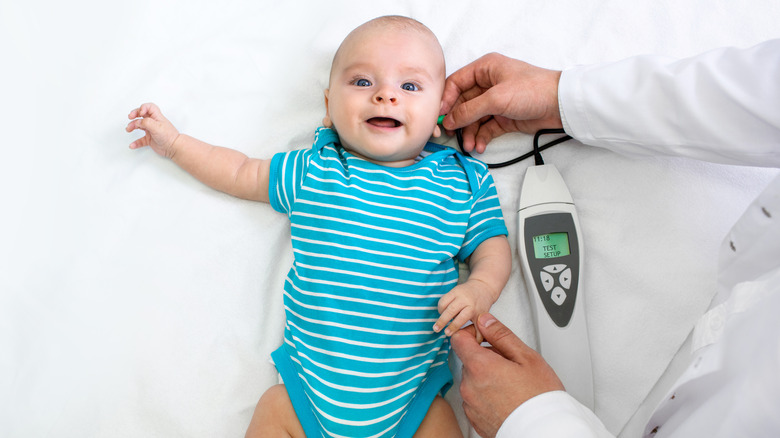The State Of U.S. Children's Hospitals During An Overwhelming Respiratory Virus Surge
This year has seen an "unprecedented" surge in the number of children being diagnosed with respiratory syncytial virus, also known as RSV, per CNN. According to the Centers for Disease Control and Prevention, RSV is "a common respiratory illness that usually causes mild, cold-like symptoms." The colder months typically see a rise in various illnesses, making it difficult to tell which virus your child may have. Luckily, there are ways that parents can tell if their child has RSV, the flu, or COVID-19.
Once a child is diagnosed with respiratory syncytial virus, parents need to be on the lookout for potentially dangerous RSV symptoms including a high fever, a cough that gets worse, wheezing, and signs of dehydration, per Intermountain Primary Children's Hospital. If a child has any difficulty breathing or starts to breathe fast, is very drowsy, or has blue lips or fingernails, parents should bring them to the emergency room immediately.
Thankfully, parents have been listening, resulting in an increase in the number of children admitted to hospitals with RSV. Unfortunately, many hospitals, including Connecticut Children's Hospital and Cook Children's in Texas, are struggling to keep up with the number of patients needing treatment. In fact, Connecticut has considered bringing in the National Guard to help care for RSV patients, per CNN.
"I've been doing this a long time. I've been at Connecticut Children's for 25 years, and I've never seen this level of surge specifically for RSV coming into our hospital," the hospital's executive vice president and physician in chief, Dr. Juan Salazar, said.
Staff shortages are causing more problems at children's hospitals
While a surge in RSV cases has caused many hospitals to become overwhelmed, staff shortages also continue to be a problem — especially with about 80% of pediatric hospital beds occupied throughout the United States. In certain states, that number is even higher. For example, in Rhode Island, beds are at 99% capacity, per CNN.
"We're extremely overwhelmed," said Dr. Rishi Lulla, director of pediatric hematology/oncology at Hasbro Children's Hospital in Providence, Rhode Island. "We're doing the best that we can to try to use the resources that we have, expand where we have capacity to expand and serve the most vulnerable kids."
The COVID-19 pandemic led to burnout, trauma, and exhaustion for many medical professionals, according to the U.S. Department of Health & Human Services. That has caused longer wait times for patients needing beds, but also more stress for the doctors and nurses left behind to pick up the slack. It is even more serious when treating children.
"The margin of error in peds is just smaller, right? So their systems are much more fragile," Dr. Marcus Schabacker, president and CEO of ECRI, an independent nonprofit focused on health-care safety and technology, told CNN. "When we talk about medication, their systems, their body system, organ system, just has much less margin for error."
With far fewer resources available than needed, the situation at many hospitals feels untenable. However, medical professionals are scrambling to ensure the children admitted to their facilities are looked after properly and that they make a full recovery.

